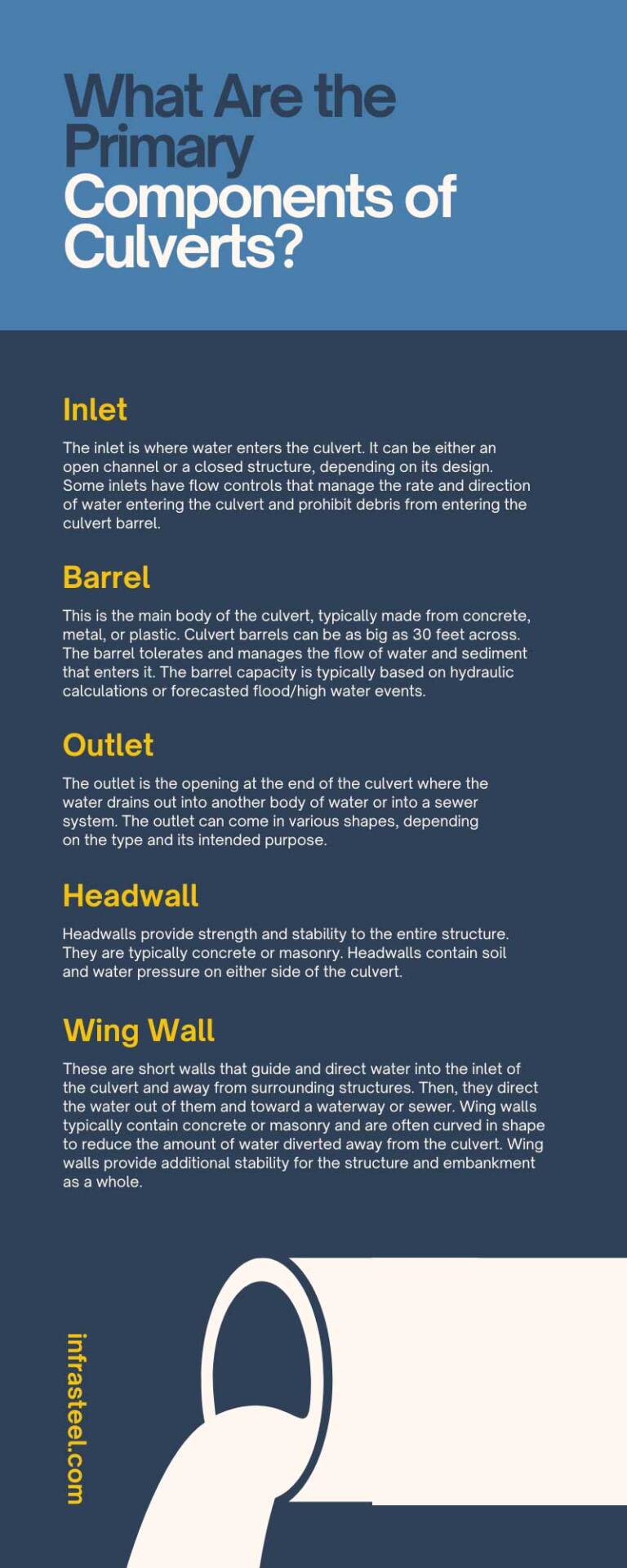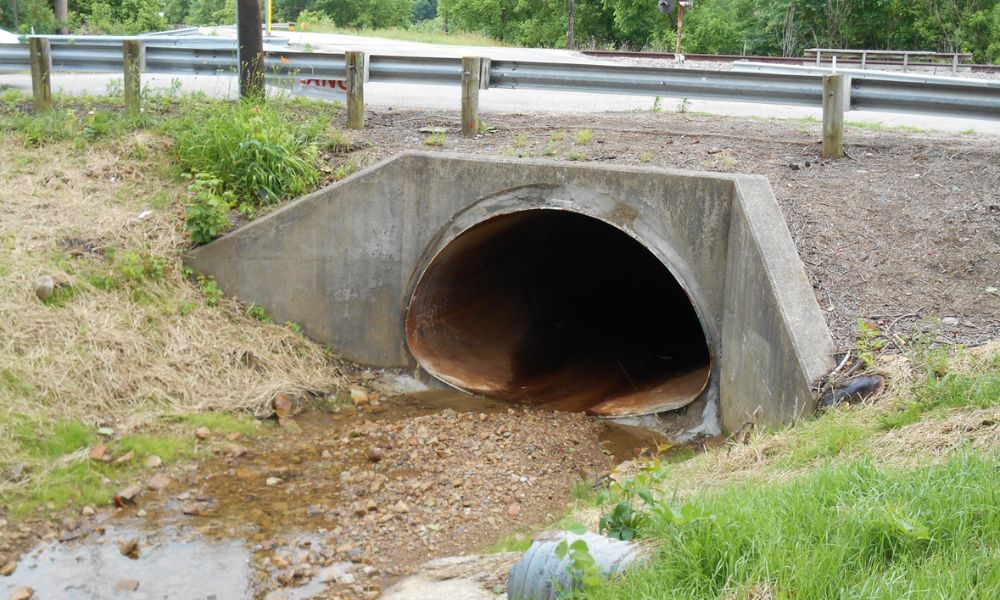Culverts are important drainage systems made of concrete, steel, brick, or stone, providing pathways for water to travel under bridges, roads, or train tracks. Some have pipe inserts made of heavy-duty plastic. However, the primary components of culverts are similar regardless of their style or type.
Types of Culverts
Arch Culverts
An arch culvert is typically stone or concrete. Arch culverts allow water to flow under bridges that cross a waterway. They usually consist of a formed arch, a closed bottom slab, an open, arched top section with concrete or stone walls, and an inlet/outlet conduit. They may also incorporate open bottom designs that keep natural streambeds intact.
Box Culverts
A box culvert contains precast concrete units coupled together to form a rectangular shape that creates a long, straight tunnel for water passage. A box culvert has headwalls and wing walls at either end, plus base slabs or bottom slabs and an inlet/outlet conduit.
Pipe Culverts
Finally, pipe culverts incorporate large tubes made from plastic or steel and are available in many different sizes. Pipe culverts contain an inlet structure (usually concrete), the pipe itself and its fittings, an outlet structure (concrete or metal), and any necessary junction structures. Plus, grout or concrete seals the pipe in place and prevents errant water from building up around the outside of the pipe.
Primary Components of Culverts
Although the design of each culvert depends on its site, the anticipated volume of water that will flow through it, and the available construction budget, most culverts have similar primary components. The following are the primary components.
Inlet
The inlet is where water enters the culvert. It can be either an open channel or a closed structure, depending on its design. Some inlets have flow controls that manage the rate and direction of water entering the culvert and prohibit debris from entering the culvert barrel.
Barrel
This is the main body of the culvert, typically made from concrete, metal, or plastic. Culvert barrels can be as big as 30 feet across. The barrel tolerates and manages the flow of water and sediment that enters it. The barrel capacity is typically based on hydraulic calculations or forecasted flood/high water events.
Outlet
The outlet is the opening at the end of the culvert where the water drains out into another body of water or into a sewer system. The outlet can come in various shapes, depending on the type and its intended purpose.
Headwall
Headwalls provide strength and stability to the entire structure. They are typically concrete or masonry. Headwalls contain soil and water pressure on either side of the culvert.
Wing Wall
These are short walls that guide and direct water into the inlet of the culvert and away from surrounding structures. Then, they direct the water out of them and toward a waterway or sewer. Wing walls typically contain concrete or masonry and are often curved in shape to reduce the amount of water diverted away from the culvert. Wing walls provide additional stability for the structure and embankment as a whole.
Base Slab/Bottom Slab
The base slab or bottom slab is an important structural component of the culvert, providing strength and stability. This component, typically made from concrete or masonry, contains the soil and water pressure below the culvert. The base slab also prevents erosion around its edges by keeping water from seeping underneath.
Embankment
The embankment is a form of soil stabilization typically made from gravel, sand, or topsoil that supports the culvert structure. The embankment slopes away from the culvert, preventing surface water and sediment runoff from entering the culvert. It also provides stability to the structure by preventing soil and other materials from eroding or washing away. In addition, an embankment can protect against flooding, as it diverts excess water safely away from the structure.
Slope
The slope refers to the angle at which water will flow through the culvert, which can range from very flat (less than 1 percent grade) to steep (over 10 percent grade). The slope determines the rate and direction at which water passes through. Note that steeper slopes can cause more erosion and may require additional engineering work.
Wear and Maintenance
All culverts must stay maintained in order to ensure optimal performance. The specific maintenance requirements vary depending on the type, so it is important to consult with an experienced professional before undertaking any repair or replacement work. Professionally installed and well-maintained culverts can provide years of reliable service.
Culverts face a number of environmental forces that can cause them to deteriorate over time. These include erosion, corrosion, sedimentation, freeze-thaw cycles, and changes in water flow. Regular maintenance ensures the culvert continues to function as intended without facing any structural damage. This maintenance includes regular inspections and repairs when necessary.
Culvert Repair and Rehabilitation
There are several different methods for repairing and rehabilitating deteriorating culverts, depending on the extent of the damage. Some common types of repairs include patching, relining, coating, and slip lining.
Steel slip liners can repair and rehabilitate corroded or weakened culvert pipes without having to completely remove and replace them. The slip-lining process involves inserting a new steel liner into the existing pipe and welding it to form a tight seal. This avoids serious traffic interruptions and saves money because it isn’t necessary to reconstruct the entire structure.
Culverts are an important part of any drainage system. Understanding the primary components of culverts, factors that lead to wear, maintenance requirements, and repair options can ensure that they continue to function properly for years to come. Keeping up with regular inspections and repairs will help you keep your structures in good working condition and will prevent costly emergency repairs or replacements in the future.
A culvert rehabilitation with custom steel slip lining from Infrasteel may be in order when maintenance crews notice serious degradation in a culvert’s structure. These forms of damage can include corrosion in a corrugated pipe, cracks or leaks in concrete walls or supports, or water encroaching on the outside of the barrel. Contact us for an inspection and estimate for remediation that will save the structure from further deterioration without the expense of a complete rebuild.




Leave A Reply